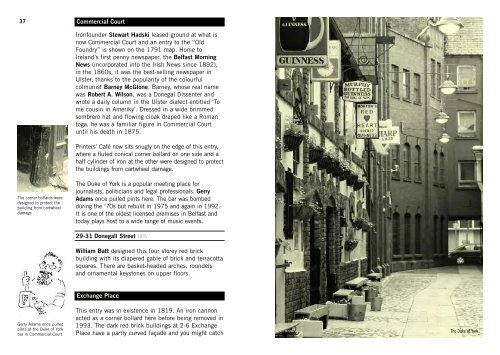Cathedral Quarter - Belfast City Council
Cathedral Quarter - Belfast City Council
Cathedral Quarter - Belfast City Council
Create successful ePaper yourself
Turn your PDF publications into a flip-book with our unique Google optimized e-Paper software.
37<br />
The corner bollards were<br />
designed to protect the<br />
building from cartwheel<br />
damage<br />
Gerry Adams once pulled<br />
pints at the Duke of York<br />
bar in Commercial Court<br />
Commercial Court<br />
Ironfounder Stewart Hadski leased ground at what is<br />
now Commercial Court and an entry to the “Old<br />
Foundry” is shown on the 1791 map. Home to<br />
Ireland’s first penny newspaper, the <strong>Belfast</strong> Morning<br />
News (incorporated into the Irish News since 1892),<br />
in the 1860s, it was the best-selling newspaper in<br />
Ulster, thanks to the popularity of the colourful<br />
colmunist Barney McGlone. Barney, whose real name<br />
was Robert A. Wilson, was a Donegal Dissenter and<br />
wrote a daily column in the Ulster dialect entitled ‘To<br />
me cousin in Ameriky’. Dressed in a wide brimmed<br />
sombrero hat and flowing cloak draped like a Roman<br />
toga, he was a familiar figure in Commercial Court<br />
until his death in 1875.<br />
Printers’ Café now sits snugly on the edge of this entry,<br />
where a fluted conical corner bollard on one side and a<br />
half cylinder of iron at the other were designed to protect<br />
the buildings from cartwheel damage.<br />
The Duke of York is a popular meeting place for<br />
journalists, politicians and legal professionals. Gerry<br />
Adams once pulled pints here. The bar was bombed<br />
during the ‘70s but rebuilt in 1975 and again in 1992.<br />
It is one of the oldest licensed premises in <strong>Belfast</strong> and<br />
today plays host to a wide range of music events.<br />
29-31 Donegall Street 1895<br />
William Batt designed this four storey red brick<br />
building with its diapered gable of brick and terracotta<br />
squares. There are basket-headed arches, roundels<br />
and ornamental keystones on upper floors.<br />
Exchange Place<br />
This entry was in existence in 1819. An iron cannon<br />
acted as a corner bollard here before being removed in<br />
1993. The dark red brick buildings at 2-6 Exchange<br />
Place have a partly curved façade and you might catch<br />
The Duke of York





